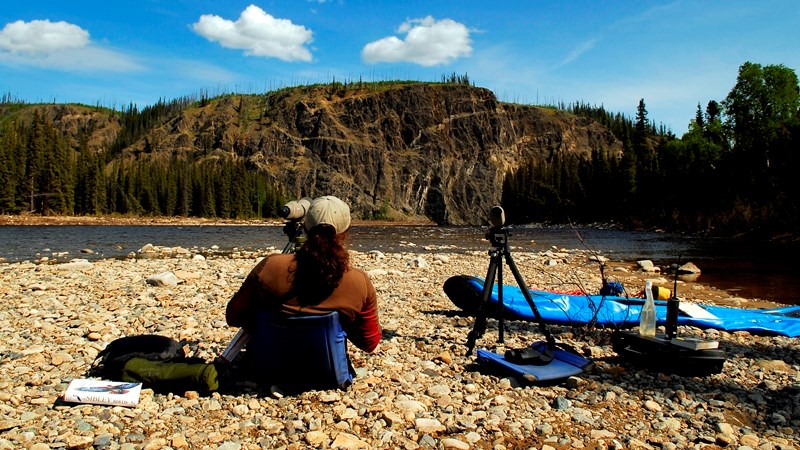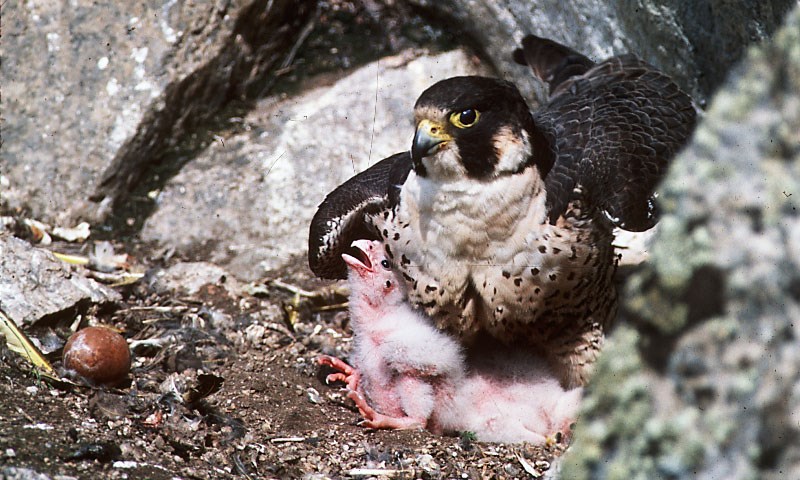
NPS Photo by Josh Spice
In 1970, the American and Arctic peregrine falcon subspecies were listed as endangered under the Endangered Species Conservation Act of 1969 (the law preceding the Endangered Species Act of 1973), reflecting their critical biological status. Peale's peregrines were never listed because they continued to breed at near normal levels and had only traces of DDT. DDT and other pesticides were not used where Peale's peregrines live, and since Peale's do not migrate and feed largely on non-migratory prey, they were not likely to pick up DDT applied elsewhere. In 1972, under the authorities granted by the Federal Insecticide, Fungicide, and Rodenticide Act (FIFRA), the Environmental Protection Agency (EPA) banned DDT for most uses in the U.S. However, DDE residues are still found in some areas of the country. DDT is gradually being phased out in many Latin American countries where some peregrines and prey spend the winter. The U.S. Fish and Wildlife Service established peregrine falcon recovery teams composed of Federal, state, and independent biologists to recommend actions necessary to restore peregrines in the U.S. As part of recovery efforts, scientists at Cornell University successfully bred and raised peregrine falcons in captivity. Under a cooperative effort among the U.S. Fish and Wildlife Service, state wildlife agencies, The Peregrine Fund, Santa Cruz Predatory Bird Research Group, and the Midwestern Peregrine Falcon Restoration Project, more than 6,000 American peregrines have been released since 1974. Large-scale reintroductions of peregrines have ceased due to the peregrine's recovery, and relatively few reintroductions are still taking place in the United States.
Visit our keyboard shortcuts docs for details
A common sight along the Yukon River, Peregrine Falcons are often seen soaring high in the sky or swiftly diving to river banks in search of prey. These magnificent birds were not always as common as they are today, their populations declined to the point of endangerment due mostly to pesticide usage. Thanks to environmental regulations of the 1970s, Peregrine Falcons were named an endangered species, and the populations in Alaska and elsewhere have rebounded naturally over time. Scientists have been studying these birds in Yukon-Charley Rivers National Preserve since the mid-1970s, and during an early study in 1975, 11 nesting pairs of falcons were documented. Today in similar surveys, over 50-60 pairs have been noted! This ongoing survey has been instrumental in tracking the Peregrine Falcon's natural recovery within Yukon-Charley Rivers National Preserve. In this video, listen to NPS Ecologist David Payer's recounting of this survey's history, as well as an inside look at how a survey crew finds these raptors for documenting.
To release captive-bred peregrines, young birds are placed in specially equipped boxes on top of a manmade tower or cliff ledge. At first, the birds are fed through a chute so they cannot see their human benefactors. When they are old enough, the box is opened and the young peregrines begin testing their wings. Their food is gradually reduced as the young falcons learn to hunt on their own. This process is known as "hacking." Arctic peregrine falcons declined by as much as 80 percent; however, enough survived the impacts of pesticides that releases of captive-bred young were not necessary. Following EPA's restrictions on the use of DDT and recovery efforts under the Endangered Species Act, Arctic peregrine numbers increased to the point that the subspecies was reclassified in 1984 from endangered to the less critical category of threatened. Then, in October 1994, the U.S. Fish and Wildlife Service announced that the Arctic peregrine falcon had increased in numbers to the point that this subspecies no longer needed Endangered Species Act protection and could safely be removed from the threatened and endangered species list. There are now thousands of Arctic peregrines in North America. In August 1999, the U.S. Fish and Wildlife Service removed the American peregrine falcon from the list of endangered and threatened species, marking one of the most dramatic successes of the Endangered Species Act. Post-delisting monitoring occurred in 2003, is being carried out in 2006, and will continue in 2009, 2012, and 2015. Results from 2003 show the population continuing to climb, and was estimated at about 3,000 breeding pairs in the U.S., Canada, and Mexico. Territory occupancy, nest success, and productivity were all at levels considered normal for healthy peregrine falcon populations. The protection afforded by the Endangered Species Act, EPA's use of their authorities under FIFRA to severely restrict the use of DDT, and the reintroduction of captive-bred chicks have rescued the peregrine falcon from extinction. A cleaner environment and the success of cooperative recovery efforts with out partners provide great promise of a bright future for the peregrine falcon in North America. The Service, with the indispensable help of partner agencies, other organizations, and volunteers, is dedicated to assuring that future through coordinated population monitoring at least through 2015. This text used in cooperation with the U.S. Fish & Wildlife Service, from the Peregrine Falcon data sheet, published in May 2006. U.S. Fish & Wildlife Service 1 800-344-WILD 
FWS Photo |
Last updated: December 7, 2017
